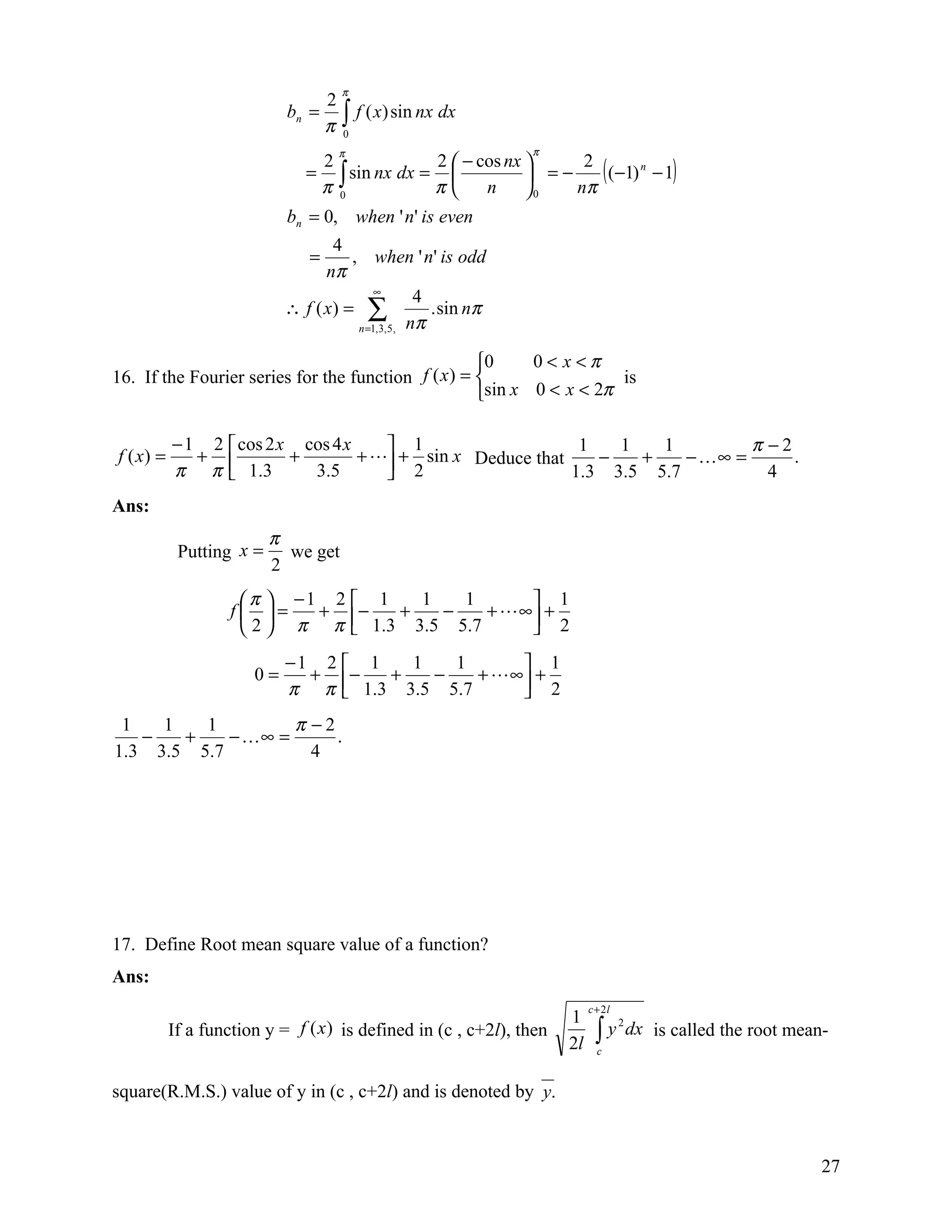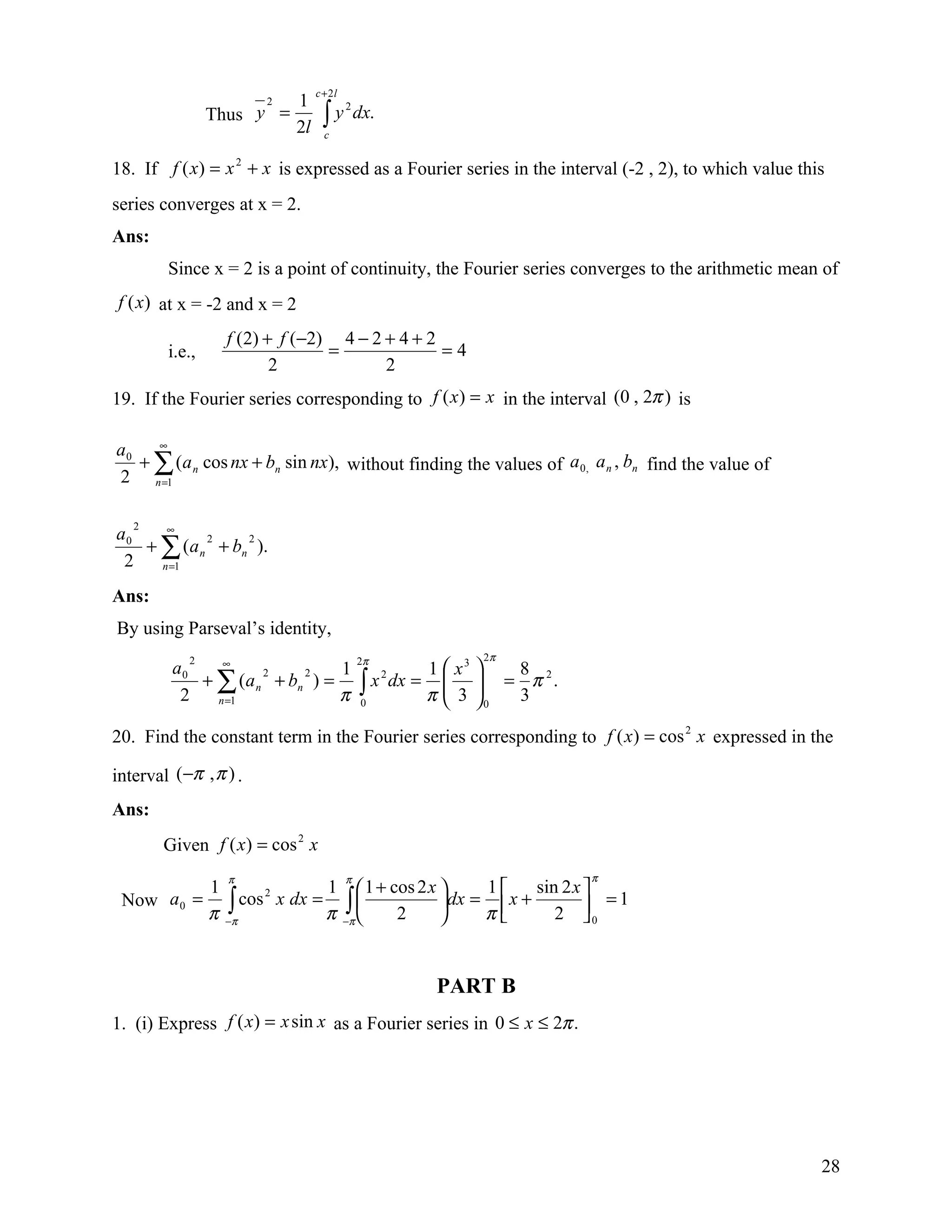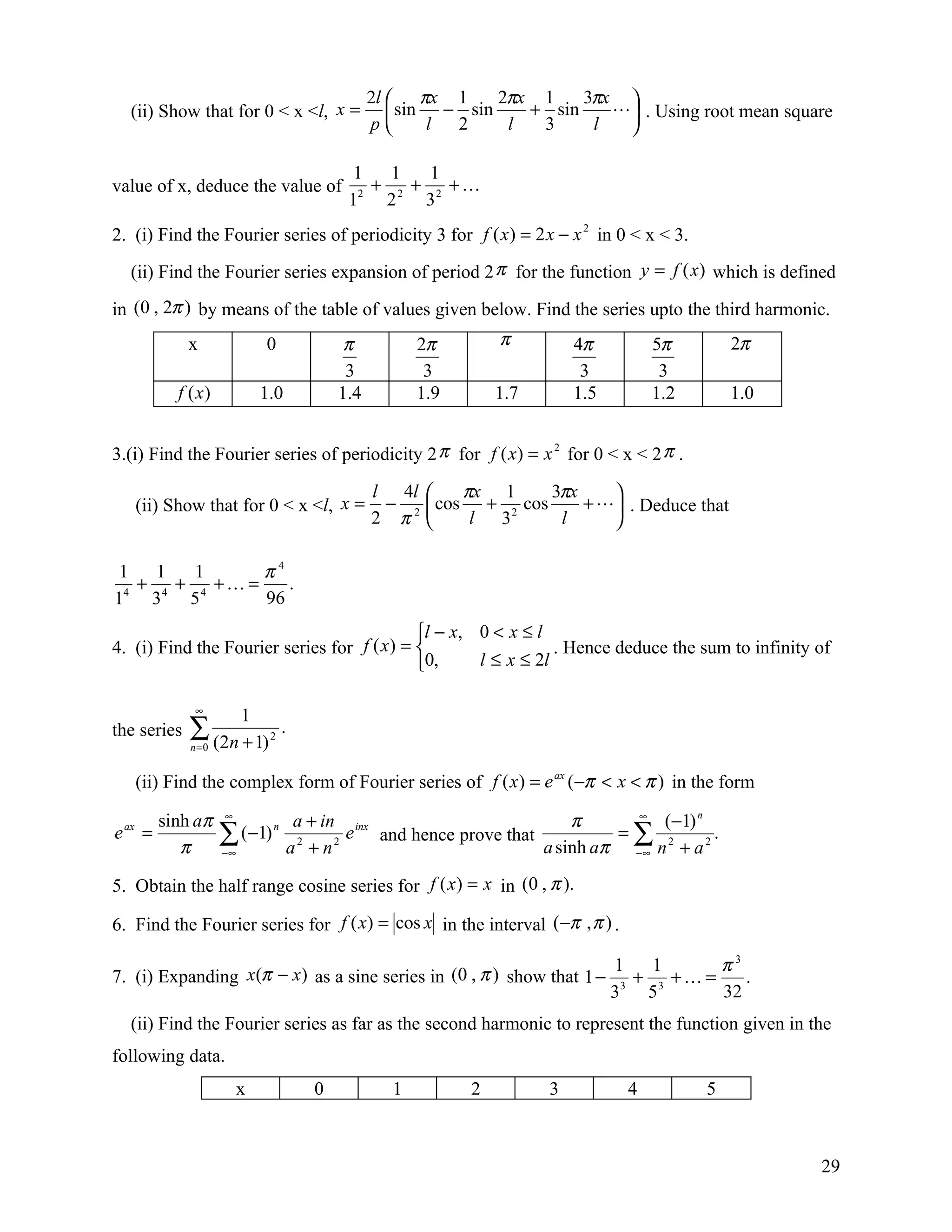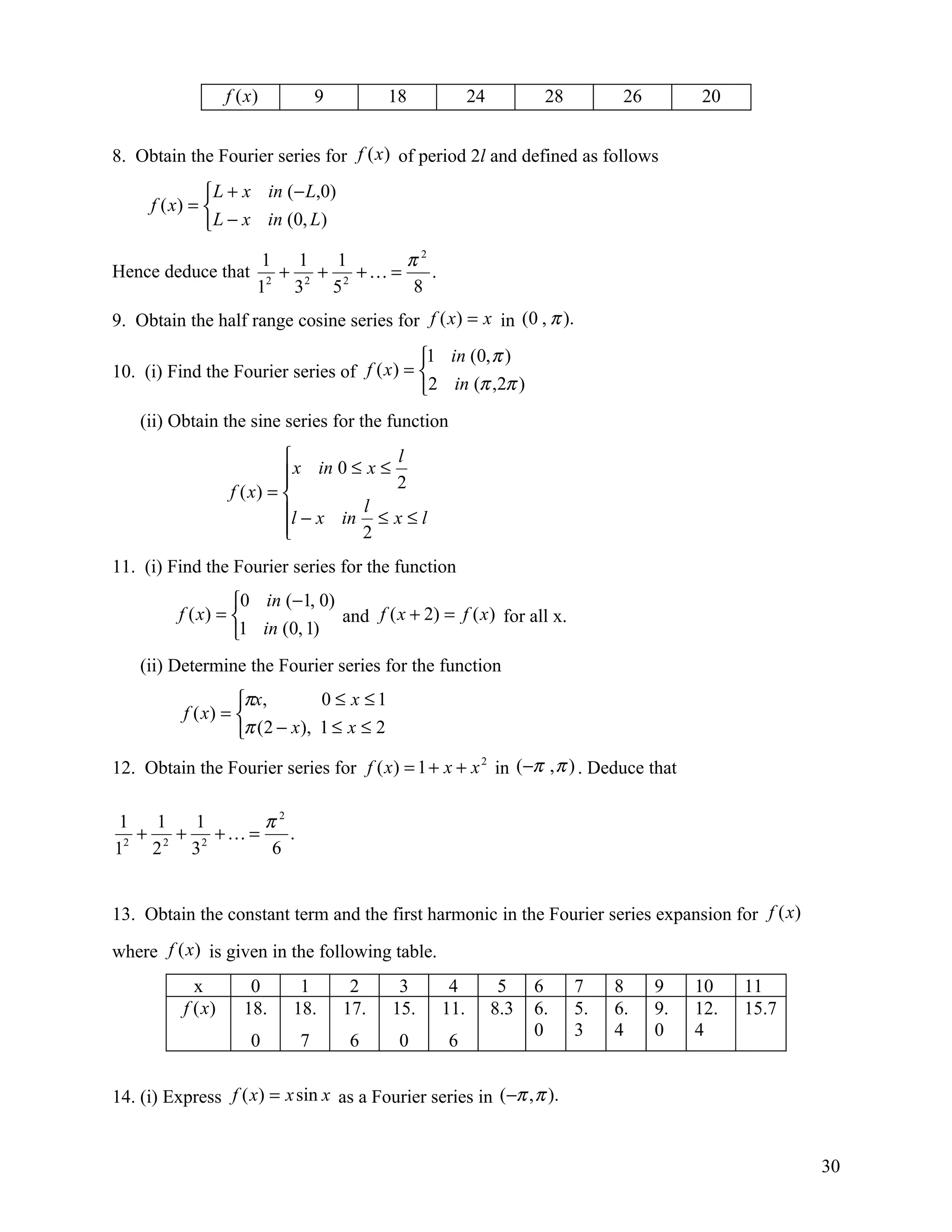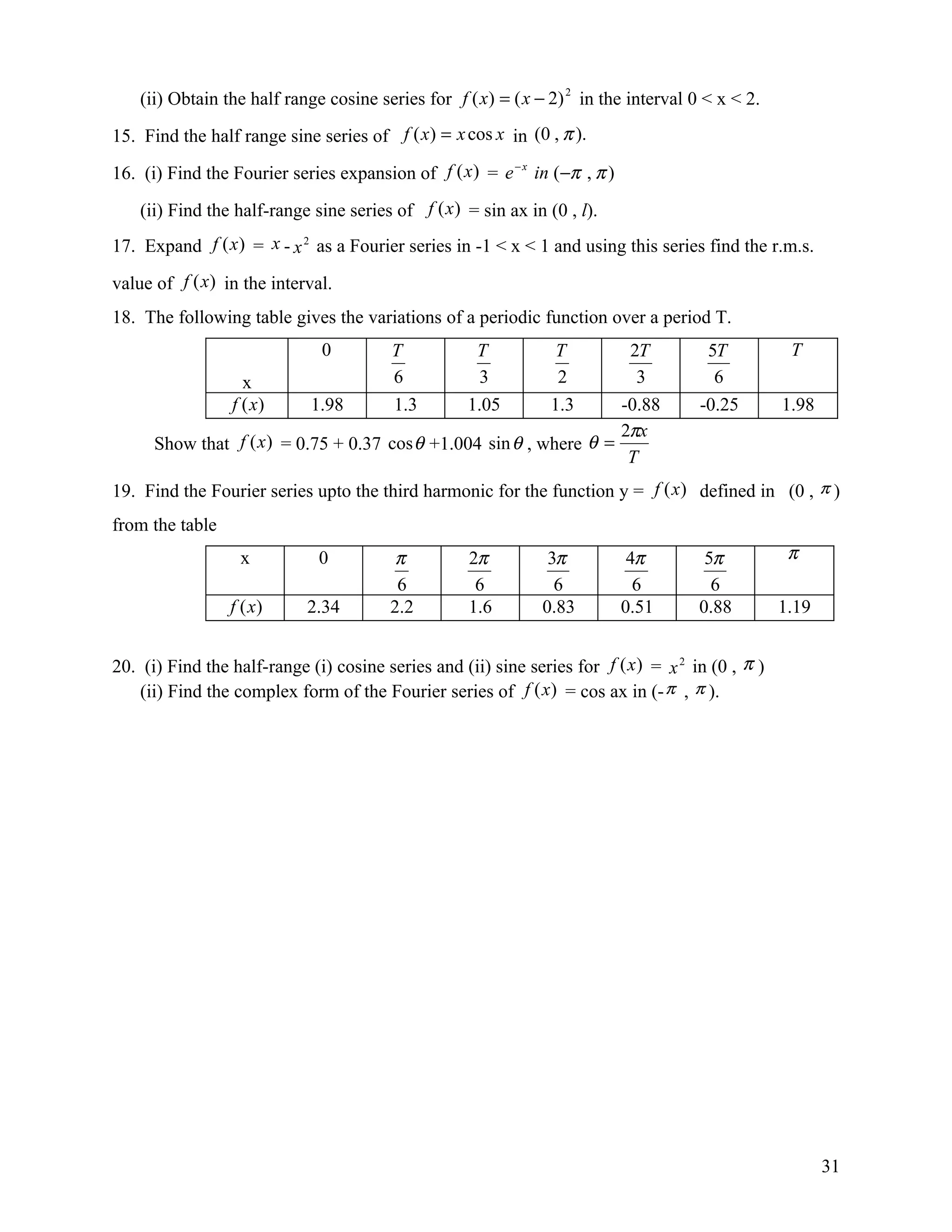The document summarizes Fourier series and related concepts:
1. It defines periodic functions and their periods, gives examples like sin x and cos x having period 2π.
2. It states Dirichlet's conditions for a function to have a Fourier series representation and defines the Fourier coefficients using Euler's formulas.
3. It explains that the Fourier series of an even function contains only cosine terms and of an odd function contains only sine terms.
4. It provides examples of even and odd functions and solves problems finding Fourier series representations of specific functions.
![CHAPTER 2
FOURIER SERIES
PERIODIC FUNCTIONS
A function f (x ) is said to have a period T if for all x, f ( x + T ) = f ( x) , where T is a
positive constant. The least value of T>0 is called the period of f (x) .
EXAMPLES
We know that f (x ) = sin x = sin (x + 4 π ) = … Therefore the function has period 2 π , 4
π , 6 π , etc. However, 2 is the least value and therefore is the period of f(x).
Similarly cos x is a periodic function with the period 2 π and tan x has period π .
DIRICHLET’S CONDITIONS
A function f (x ) defined in c ≤ x ≤ c+2l can be expanded as an infinite trigonometric
a nπx nπx
series of the form o + ∑ a n cos + ∑ bn sin , provided
2 l l
1. f (x) is single- valued and finite in (c , c+2l)
2. f (x) is continuous or piecewise continuous with finite number of finite
discontinuities in (c , c+2l).
3. f (x) has no or finite number of maxima or minima in (c , c+2l).
EULER’S FORMULAS
If a function f (x) defined in (c , c+2l) can be expanded as the infinite trigonometric
ao ∞
nπx ∞ nπx
series
2
+ ∑ an cos
n =1 l
+ ∑ bn sin
n =1 l
then
c + 2l
1 nπx
an =
l ∫
c
f ( x) cos
l
dx, n ≥ 0
c + 2l
1 nπx
bn =
l ∫c
f ( x) sin
l
dx, n ≥ 1
[ Formulas given above for a n and bn are called Euler’s formulas for Fourier coefficients]](https://image.slidesharecdn.com/chapter2maths3-110725025309-phpapp01/75/Chapter-2-maths-3-1-2048.jpg)
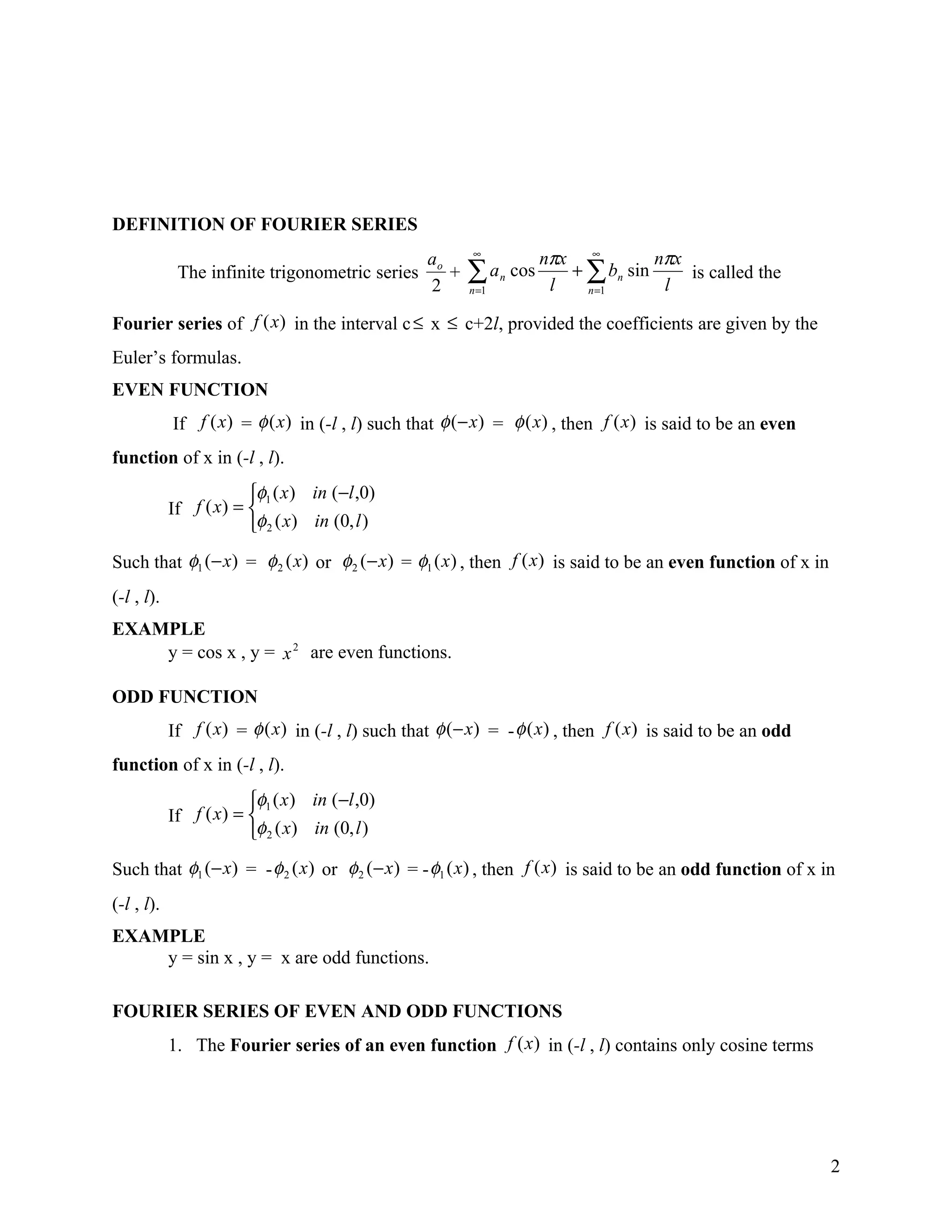
![(constant term included), i.e. the Fourier series of an even function f (x) in (-l , l) is
given by
ao nπx
f (x) =
2
+ ∑a n cos
l
,
nπx
l
2
where a n = ∫ f ( x ) cos dx.
l 0 l
2. The Fourier series of an odd function f (x) in (-l , l) contains only sine terms, i.e.
the Fourier series of an odd function f (x ) in (-l , l) is given by
nπx
f (x) = ∑b n sin
l
,
nπx
l
2
where bn = ∫ f ( x) sin l dx.
l 0
PROBLEMS
1. Find the Fourier series of period 2l for the function f (x ) = x(2l – x) in (0 , 2l). Deduce
1 1 1
the sum of f (x) = 2
− 2 + 2 −
1 2 3
Solution:
ao ∞
nπx ∞ nπx
Let f (x ) =
2
+ ∑a
n =1
n cos
l
+ ∑ bn sin
n =1 l
in (0 , 2l) …………(1)
nπx
2l
1
an =
l0∫ x(2l − x) cos l dx
2l
nπx nπx nπx
sin − cos − sin
1 2 l − (2l − 2 x ) l + (−2) l ,
= (2lx − x )
l nπ n 2π 2 n 3π 3
l l2 l3 0
using Bernoulli’s formula.
2
1
= [ − 2l cos 2nπ − 2l ] = − 4l 2
n 2π 2 n 2π
2l
1 x3
2l
1 4
a o = ∫ x(2l − x )dx = lx 2 − = l 2 .
l0 l 3 0 3
3](https://image.slidesharecdn.com/chapter2maths3-110725025309-phpapp01/75/Chapter-2-maths-3-3-2048.jpg)
![nπx
2l
1
bn =
l0∫ x(2l − x) sin l dx
=0
Using these values in (1), we have
2 2 4l 2 ∞
1 nπx
x (2l - x) = l − 2
3 π
∑n
n =1
2
cos
l
in (0, 2l) ……………..(2)
1 1 1
The required series 2
− 2 + 2 − … ∞ can be obtained by putting x = l in the Fourier
1 2 3
series in (2).
x = l lies in (0 , 2l) and is a point of continuity of the function f (x) = x(2l – x).
∴ [ Sum the Fourier series in (2) ] x =1 = f(l)
∞
2 2 4l 2 1
i.e. l − 2
3 π
∑n
n =1
2
cos nπ = l(2l - l)
4l 2 1 1 1 l
2
i.e.. - − 2 + 2 − 2 + ...∞ =
π2 1 2 3 3
∴
1 1 1 π2
− 2 + 2 − …∞ =
12 2 3 12
2. Find the Fourier series of period 2 π for the function f (x) = x cos x in 0 < x < 2 π .
Solution:
∞ ∞
ao
Let f (x ) =
2
+ ∑ an cos nx + ∑ bn sin nx
n =1 n =1
.……..…………(1)
2π
1
an =
π ∫ x cos x cos nxdx
0
2π
1
=
2π ∫ x[ cos(n + 1) x + cos(n − 1) x]dx
0
1 sin( n + 1) x cos(n + 1) x 2π sin( n − 1) x cos(n − 1) x 2π
= x. + + x. + ,
2π n +1 (n + 1) 2 0 n −1 ( n − 1) 2 0
if n ≠ 1
=0, if n ≠ 1
ao = 0
4](https://image.slidesharecdn.com/chapter2maths3-110725025309-phpapp01/75/Chapter-2-maths-3-4-2048.jpg)
![2π 2π
1 1
an = ∫ x cos xdx = 2π ∫ x(1 + cos 2 x)dx
2
π 0 0
2π
1 x sin 2 x cos 2 x
2
= +x + = π.
2π 2 2 4 0
2π
1
bn =
π ∫ x cos x sin nxdx
0
2π
1
=
2π ∫ x[ sin(n + 1) x + sin(n − 1) x]dx
0
1 − cos(n + 1) x sin( n + 1) x 2π − cos(n − 1) x sin( n − 1) x 2π
= x. + + x. + ,
2π n +1 (n + 1) 2 0 n −1 (n − 1) 2 0
if n ≠ 1
1 1 1 1 2n
=− − = − + =− 2 , if n ≠ 1
n +1 n −1 n + 1 n − 1 n −1
2π 2π
1 1
b1 =
π ∫ x cos x sin xdx =
0
2π ∫ x sin 2 xdx
0
2π
1 − cos 2 x sin 2 x 1
= x + =−2
2π 2 4 0
Using these values in (1), we get
∞
1 n
f(x) = π cos x − sin x − 2 ∑ sin nx
n = 2 , 3,... n − 1
2
2
3. Find the Fourier series expansion of f (x) = sin ax in (-l , l).
Solution:
Since f (x) is defined in a range of length 2l, we can expand f (x ) in Fourier series of
period 2l.
Also f ( − x) = sin[a(-x)] = -sin ax = - f (x)
∴ f (x) is an odd function of x in (-l , l).
Hence Fourier series of f (x ) will not contain cosine terms.
∞
nπx
Let f (x ) = ∑b
n =1
n sin
l
………………….(1)
5](https://image.slidesharecdn.com/chapter2maths3-110725025309-phpapp01/75/Chapter-2-maths-3-5-2048.jpg)
![1 nπ nπ
l
= ∫ cos l − a − cos l + a xdx
l 0
l
nπ nπ
1 sin l − a x sin l + a x
= −
l nπ nπ
−a +a
l l
0
1 nπ 1 nπ
= sin − a l − sin + a l
nπ − la l nπ + la l
=
1
nπ − al
{− (−1) n sin al} − nπ 1 al {(−1) n sin al}
+
1 1
= (−1) n +1 sin al +
nπ − al nπ + al
(−1) n +1 2nπ sin al
=
n 2π 2 − a 2 l 2
Using these values in (1), we get
∞
(−1) n +1 n nπx
sin ax = 2π sin al ∑ sin
n =1 n π −a l
2 2 2 2
l
4. Find the Fourier series expansion of f (x) = e − x in (−π , π ) . Hence obtain a series for
cosec π
Solution:
Though the range (−π , π ) is symmetric about the origin, e − x is neither an even function
nor an odd function.
∞ ∞
ao
∴ Let f (x) =
2
+ ∑ an cos nx + ∑ bn sin nx
n =1 n =1
..…..…………(1)
in (−π , π ) [ the length of the range is 2π ]
6](https://image.slidesharecdn.com/chapter2maths3-110725025309-phpapp01/75/Chapter-2-maths-3-6-2048.jpg)
![π
1
∫π e cos nxdx
−x
an =
π−
π
1 e −x
= 2 ( − cos nx + n sin nx )
π n +1 −π
=−
1
{e −π
(−1) n − e π (−1) n }
π ( n + 1)
2
2( −1) n
= sinh π
π (n 2 + 1)
2 sinh π
ao =
π
π
1
∫π e sin nxdx
−x
bn =
π−
π
1 e −x
= 2 ( − sin nx − n cos nx )
π n +1 −π
=−
n
{e −π
(−1) n − e π (−1) n }
π ( n 2 + 1)
2n(−1) n
= sinh π
π (n 2 + 1)
Using these values in (1), we get
sinh π 2 sinh π ∞
(−1) n 2 sinh π ∞
(−1) n n
e−x =
π
+
π
∑ n 2 + 1 cos nx + π
n =1
∑ n 2 + 1 sin nx
n =1
in (−π , π )
[ Sum of the Fourier series of f ( x )] x =0 = f (0),
[Since x=0 is a point of continuity of f(x)]
sinh π ∞
(−1) n
i.e., 1 + 2∑ 2 −0
= e =1
π n =1 n + 1
−1 ∞
(−1) n
i.e., π cos ech π = 1 + 2 + 2∑ 2
2 n=2 n + 1
2 ∞ (−1) n
i.e., cos ech π = ∑
π n=2 n 2 + 1
7](https://image.slidesharecdn.com/chapter2maths3-110725025309-phpapp01/75/Chapter-2-maths-3-7-2048.jpg)
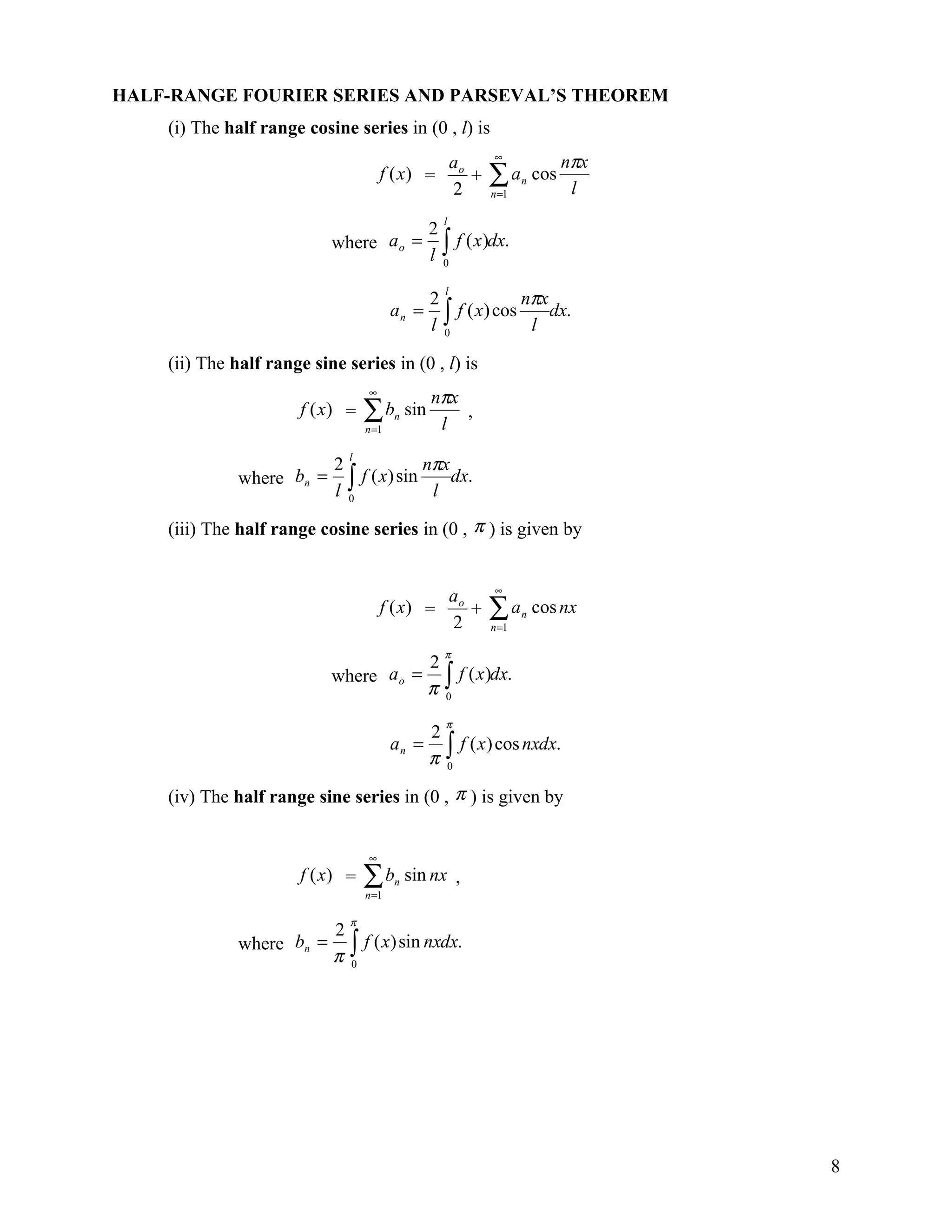
![ROOT-MEAN SQUARE VALUE OF A FUNCTION
Definition
c +2 l
1
∫y
2
If a function y = f (x ) is defined in (c , c+2l), then dx is called the root mean-
2l c
square(R.M.S.) value of y in (c , c+2l) and is denoted by y.
c + 2l
1 2
Thus y = ∫y
2
dx.
2l c
PARSEVAL’S THEOREM
If y = f (x ) can be expanded as a Fourier series of the form
ao ∞
nπx ∞ nπx
2
+ ∑ an cos
n =1 l
+ ∑ bn sin
n =1 l
in (c , c+2l), then the root-mean square value y of y = f (x)
in (c , c+2l) is given by
1 2 1 ∞ 1 ∞
y = a o + ∑ a n + ∑ bn
2 2 2
4 2 n =1 2 n =1
PROOF
ao ∞
nπx ∞ nπx
f (x) =
2
+ ∑ an cos
n =1 l
+ ∑ bn sin
n =1 l
in (c , c+2l) ....……………….(1)
∴ By Euler’s formulas for the Fourier coefficients,
c + 2l
1 nπx
an =
l ∫ c
f ( x) cos
l
dx, n ≥ 0 ..…………………(2)
c + 2l
1 nπx
bn =
l ∫
c
f ( x) sin
l
dx, n ≥ 1 …....……………..(3)
Now, by definition,
c + 2l c + 2l
1 1
∫ [ f ( x)]
2
∫ y dx =
2
y = 2
dx
2l c
2l c
c + 2l
1 a ∞
nπx ∞ nπx
= ∫ f ( x) o + ∑ a n cos + ∑ bn sin dx, using (1)
2l c 2 n =1 l n =1 l
ao1 c + 2l ∞ a 1 c + 2l nπx ∞ bn 1
c + 2l
nπx
= ∫ f ( x)dx + ∑ n ∫ f ( x) cos dx + ∑ ∫ f ( x) sin dx
4 l c n =1 2 l c l n =1 2 l c l
∞ ∞
ao an bn
= .a o + ∑ .a n + ∑ .bn , by using (2) and (3)
4 n =1 2 n =1 2
9](https://image.slidesharecdn.com/chapter2maths3-110725025309-phpapp01/75/Chapter-2-maths-3-9-2048.jpg)
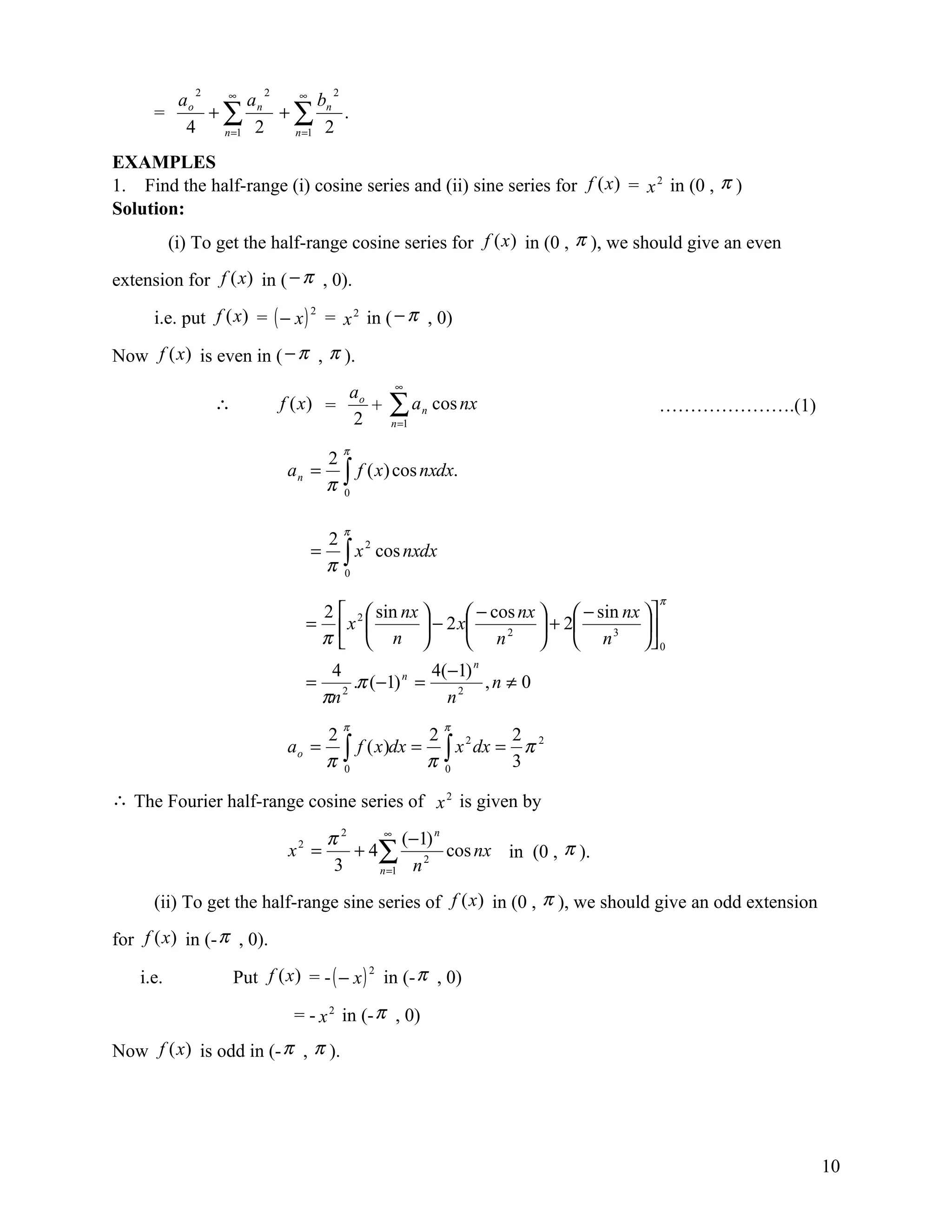
![∞
∴ f (x) = ∑b
n =1
n sin nx ……………….(2)
π π
2 2
bn = ∫ f ( x) sin nxdx = ∫ x 2 sin nxdx
π 0 π 0
π
2 cos nx sin nx cos nx
= x2 − − 2 x − + 2
π n n 2 n 3 0
2 π 2
(−1) + 3 {(−1) − 1}
n +1 2
= n
π n n
2 π 2 4
− , if n is odd
= π n n 3
− 2π , if n is even
n
Using this value in(2), we get the half-range sine series of x 2 in (0 , π ).
2. Find the half-range sine series of f (x) = sin ax in (0 , l).
Solution:
We give an odd extension for f (x) in (-l , 0).
i.e. we put f (x) = -sin[a(-x)] = sin ax in (-l , 0)
∴ f (x) is odd in (-l , l)
∞
nπx
Let f (x ) = ∑b
n =1
n sin
l
nπx
l
2
bn = ∫ sin ax. sin l dx
l 0
1 nπ nπ
l
= ∫ cos l − a x − cos l + a x dx
l 0
l
nπ nπ
1 sin l − a x sin l + a x
= −
l nπ nπ
l − a + a
l 0
1 1
= (−1) n +1 sin ( nπ − al ) − sin ( nπ + al )
nπ − al nπ + al
11](https://image.slidesharecdn.com/chapter2maths3-110725025309-phpapp01/75/Chapter-2-maths-3-11-2048.jpg)
![1 1
= (−1) n +1 sin al + ( −1) n +1 sin al
nπ − al nπ + al
2nπ
= (−1) n +1 sin al. 2 2
n π − a 2l 2
Using this values in (1), we get the half-range sine series as
∞
(−1) n +1 .n nπx
sin ax = 2π sin al ∑ 2 2 sin
n =1 n π − a l
2 2
l
3. Find the half-range cosine series of f (x ) = a in (0 , l). Deduce the sum of
1 1 1
2
+ 2 + 2 + ∞ .
1 3 5
Solution:
Giving an odd extension for f (x) in (-l , 0), f (x ) is made an odd function in (-l , l).
nπx
∴ Let f(x) = ∑b n sin
l
..……………(1)
nπx
l
2
bn = ∫ a sin dx
l 0 l
l
nπx
− cos l
=
2a
nπ
l
=
2a
nπ
1 − ( − 1)
n
{ }
l 0
4a
, if n is odd
= nπ
0,
if n is even
Using this value in (1), we get
4a ∞ 1 nπx
a= ∑5 n sin l in (0 , l )
π n =1,3,
Since the series whose sum is required contains constant multiples of squares of bn , we apply
Parseval’s theorem.
l
1 1
∑ bn = l ∫ [ f ( x)] dx
2 2
2 0
12](https://image.slidesharecdn.com/chapter2maths3-110725025309-phpapp01/75/Chapter-2-maths-3-12-2048.jpg)
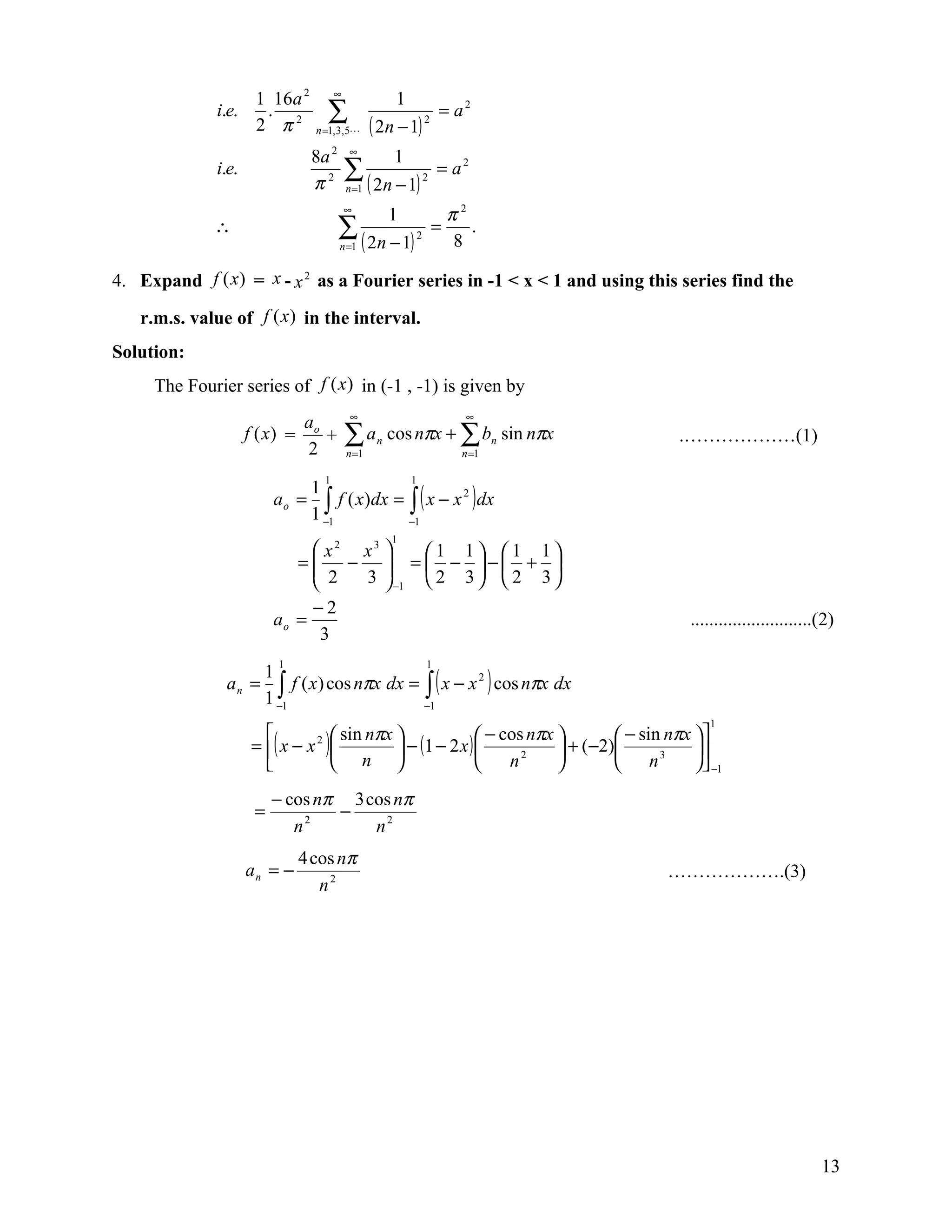

![The co-efficients a o , a n , bn are
2π 2 4(−1) n
ao = , an = , bn = 0
3 n2
Parseval’s theorem is
(a )
π ∞
1 1 2 1
∫ [ f ( x)] dx = ao + ∑
2 2 2
n + bn
2π −π
4 2 n =1
ao 2 1 ∞ 2
( )
π
∫ [x ] + ∑ a n + bn
2 2
dx = 2π
2
∴
−π 4
2 n =1
π
x5 π 4 1 ∞ 16
i.e.,
5 = 2π
+ ∑ 4
−π 9 2 n =1 n
2π 5 2π 5 ∞
16
i.e., − =π∑ 4
5 9 n =1 n
8π 4 ∞
16
=∑ 4
45 n =1 n
∞
1 π4
i.e., ∑ n 4 = 90
n =1
1 1 1 π4
i.e., + 2 + 2 + ∞ =
12 3 5 90
HARMONIC ANALYSIS
The process of finding the Fourier series for a function given by numerical value is
known as harmonic analysis. In harmonic analysis the Fourier coefficients ao , a n , and bn of the
function y = f (x) in (0 , 2 π ) are given by
a o = 2[mean value of y in (0 , 2 π )]
a n = 2[mean value of y cos nx in (0 , 2 π )]
bn = 2[mean value of y sin nx in (0 , 2 π )]
(i) Suppose the function f (x) is defined in the interval (0 , 2l), then its Fourier series is,
ao ∞
nπx ∞ nπx
f (x) =
2
+ ∑a
n =1
n cos
l
+ ∑ bn sin
n =1 l
and now, a o = 2[mean value of y in (0 , 2l)]
nπx
a n = 2 mean value of y cos in (0 , 2l )
l
15](https://image.slidesharecdn.com/chapter2maths3-110725025309-phpapp01/75/Chapter-2-maths-3-15-2048.jpg)
![ nπx
bn = 2 mean value of y sin in (0 , 2l )
l
(ii) If the half range Fourier sine series of f (x) in (0 , l) is,
∞
nπx
f (x) = ∑b
n =1
n sin
l
, then
nπx
bn = 2 mean value of y sin in (0 , l )
l
(iii) If the half range Fourier sine series of f (x) in (0 , π ) is,
∞
nπx
f (x) = ∑b
n =1
n sin
l
, then
bn = 2[ mean value of y sin nx in (0 , π )]
(iv) If the half range Fourier cosine series of f (x) in (0 , l) is,
ao ∞
nπx
f (x) = + ∑ a n cos , then
2 n =1 l
a o = 2[mean value of y in (0 , l)]
nπx
a n = 2 mean value of y cos in (0 , l )
l
(v) If the half range Fourier cosine series of f (x) in (0 , π ) is,
ao ∞
nπx
f (x) =
2
+ ∑a
n =1
n cos
l
, then
a o = 2[mean value of y in (0 , π )]
a n = 2[ mean value of y cos nx in (0 , π )] .
EXAMPLES
1. The following table gives the variations of a periodic function over a period T.
0 T T T 2T 5T T
x 6 3 2 3 6
f (x) 1.98 1.3 1.05 1.3 -0.88 -0.25 1.98
2πx
Show that f (x ) = 0.75 + 0.37 cos θ +1.004 sin θ , where θ =
T
Solution:
Here the last value is a mere repetition of the first therefore we omit that value and
consider the remaining 6 values. ∴ n = 6.
16](https://image.slidesharecdn.com/chapter2maths3-110725025309-phpapp01/75/Chapter-2-maths-3-16-2048.jpg)
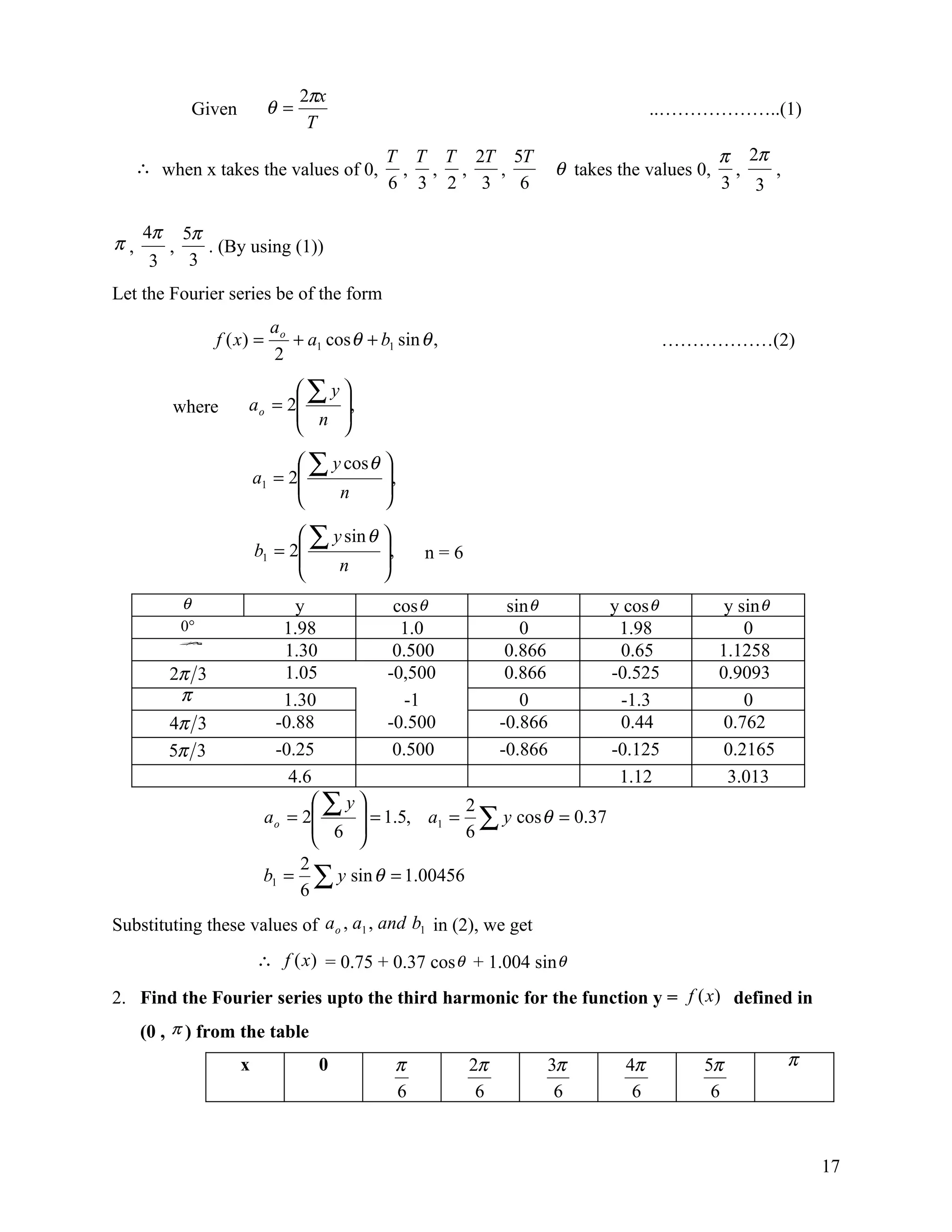
![f (x) 2.34 2.2 1.6 0.83 0.51 0.88 1.19
Solution:
We can express the given data in a half range Fourier sine series.
f ( x) = b1 sin x + b2 sin 2 x + b3 sin 3 x ..………………...(1)
x y = f(0) sin x sin 2x sin 3x y sin x y sin 2x y sin 3x
0 2.34 0 0 0 0 0 0
30 2.2 0.5 0.87 1 1.1 1.91 2.2
60 1.6 0.87 0.87 0 1.392 1.392 0
90 0.83 1 0 -1 0.83 0 -0.83
120 0.51 0.87 -0.87 0 0.44 -0.44 0
150 0.88 0.5 -0.87 1 0.44 0.76 0.88
180 1.19 0 0 0 0 0 0
4.202 3.622 2.25
∑ y sin x 1
Now b1 = 2 = [ 4.202] = 1.40
6 3
∑ y sin 2 x 1
b2 = 2 = [ 3.622] = 1.207
6 3
∑ y sin 3 x 1
b3 = 2 = [ 2.25] = 0.75
6 3
Substituting these values in (1), we get
f (x) = 1.4 sin x + 1.21 sin 2x + 0.75 sin 3x
3. Compute the first two harmonics of the Fourier series for f(x) from the following data
x 0 30 60 90 120 150 180
f (x ) 0 5224 8097 7850 5499 2626 0
Solution:
Here the length of the interval is π . ∴ we can express the given data in a half range
Fourier sine series
i.e., f ( x) = b1 sin x + b2 sin 2 x ………………………(1)
18](https://image.slidesharecdn.com/chapter2maths3-110725025309-phpapp01/75/Chapter-2-maths-3-18-2048.jpg)
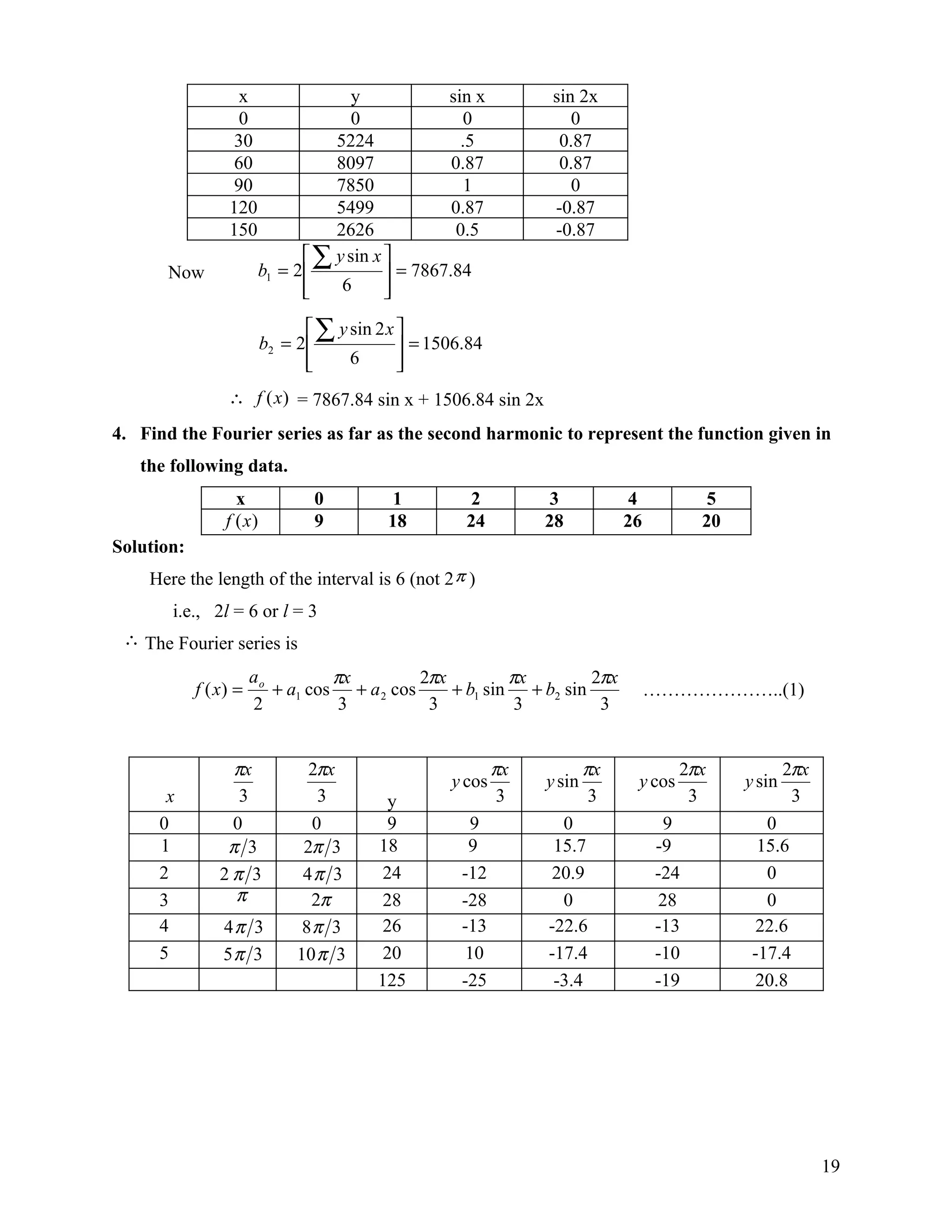
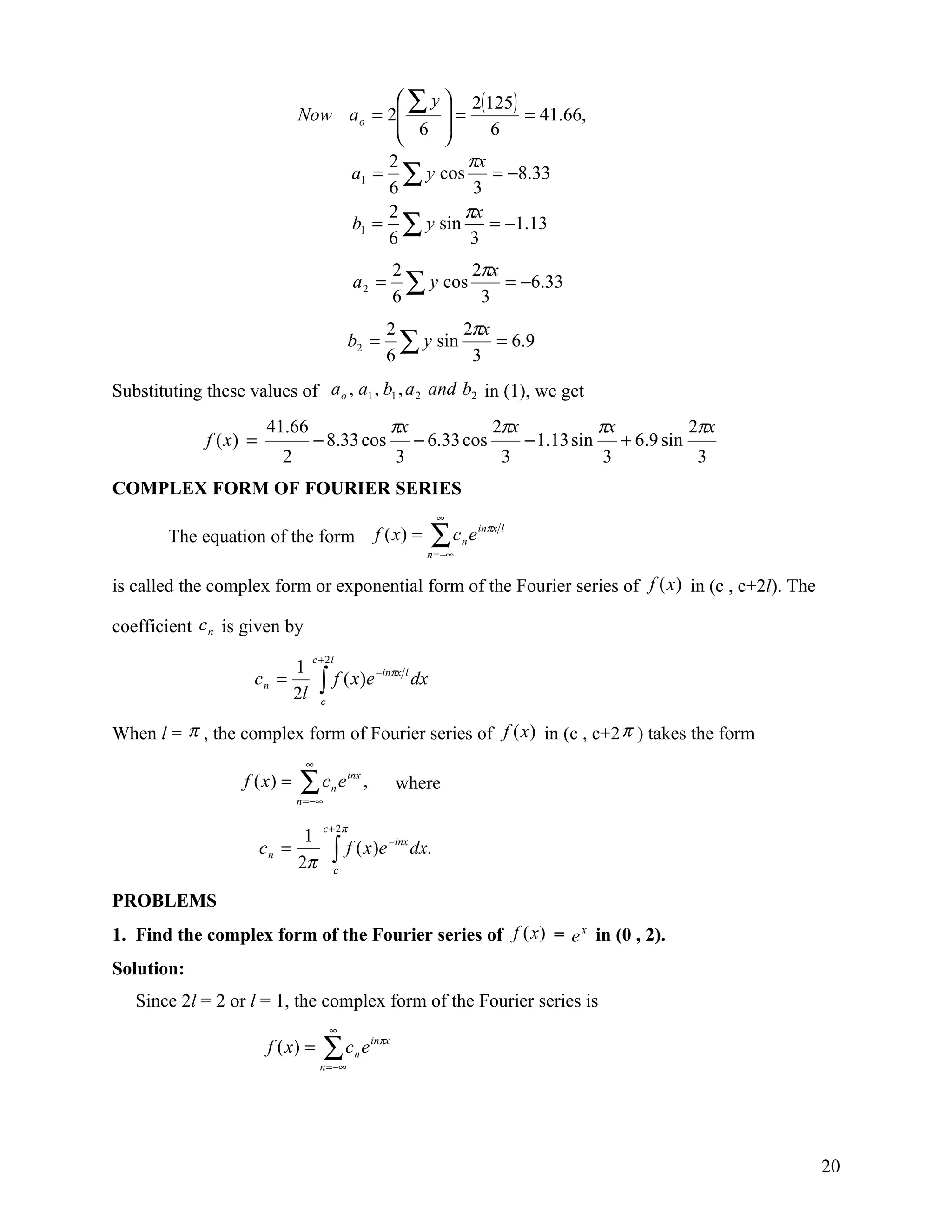
![2
1
c n = ∫ f ( x)e −inπx dx
20
2
1
= ∫ e x e −inπx dx
20
2
1 e ( 1−inπ ) x
=
2 1 − inπ 0
=
1
2(1 − inπ )
{e 2(1−inπ ) − 1}
=
(1 + inπ ) {e ( cos 2nπ − i sin 2nπ ) − 1}
2
2(1 + n π 2 2
)
=
(e 2
− 1)(1 + inπ )
2(1 + n 2π 2 )
Using this value in (1), we get
e 2 − 1 ∞ (1 + inπ ) inπx
2 ∑ (1 + n 2π 2 ) e
ex =
n =−∞
2. Find the complex form of the Fourier series of f (x) = sin x in (0 , π ).
Solution:
Here 2l = π or l = π 2 .
∴ The complex form of Fourier series is
∞
f ( x) = ∑c e
n = −∞
n
i 2 nx
…………………..(1)
π
1
c n = ∫ sin xe −i 2 nx dx
π 0
π
1 e −i 2 nx
= { − i 2n sin x − cos x}
π 1 − 4n
2
0
=
1
π ( 4n − 1)
2
[
− e i 2 nx − 1 = − ] 2
π ( 4n 2 − 1)
Using this value in (1), we get
2 ∞ 1
sin x = − ∑ 4n 2 − 1 .e i 2nx
π n =−∞
in (0 , π )
3. Find the complex form of the Fourier series of f (x) = e − ax in (-l , l).
Solution:
21](https://image.slidesharecdn.com/chapter2maths3-110725025309-phpapp01/75/Chapter-2-maths-3-21-2048.jpg)
![Let the complex form of the Fourier series be
∞
f ( x) = ∑c e
n = −∞
n
inπx l
l
1
c n = ∫ f ( x)e −inπx l dx
2l −l
l
1
= ∫ e − ax e −inπx l dx
2l −l
l
1
= ∫ e −( al +inπ ) x / l dx
2l −l
l
1 e −( al +inπ ) x l
=
2l − ( al + inπ ) l −l
=
1
2( al + inπ )
[
e −( al +inπ ) − e ( al +inπ ) ]
=
2
1
( al + inπ )
[
e al (−1) n − e − al (−1) n ]
[ e ± inπ
= cos nπ ± i sin nπ = (−1) n ]
sinh al (−1) n
=
al + inπ
sinh al.( al − inπ ) (−1) n
=
a 2 l 2 + n 2π 2
Using this value in (1), we have
∞
(−1) n ( al − inπ ) inπx l
e − ax = sinh al ∑ 22 2 2 e
n = −∞ a l + n π
in (-l , l)
4. Find the complex form of the Fourier series of f (x) = cos ax in (- π , π ), where a is
neither zero nor an integer.
Solution:
Here 2l = 2 π or l = π .
∴ The complex form of Fourier series is
∞
f ( x) = ∑c e
n = −∞
n
inx
………………….(1)
22](https://image.slidesharecdn.com/chapter2maths3-110725025309-phpapp01/75/Chapter-2-maths-3-22-2048.jpg)
![π
1
∫π cos ax.e
− inx
cn = dx
2π −
π
1 e −inx
= 2 { − in cos ax + a sin ax}
2π a − n 2
−π
=
1
2π ( a − n 2 )
2
[
e −inπ ( − in cos aπ + a sin aπ ) − e inπ ( − in cos aπ − a sin aπ ) ]
1
= (−1) n 2a sin aπ
2π ( a − n )
2 2
Using this value in (1), we get
a sin aπ ∞
(−1) n inx
cos ax =
π
∑
n = −∞ a2 − n2
e in (- π , π ).
UNIT 2
PART – A
1. Determine the value of a n in the Fourier series expansion of f ( x) = x 3 in − π < x < π .
Ans: f ( x) = x 3 is an odd function.
∴ an = 0
2. Find the root mean square value of f ( x) = x 2 in the interval (0 , π ) .
Ans:
RMS Vale of f ( x ) = x 2 in (0 , π ) is
π π π
1 x5
∫ [x ]
2 1 2 2 1
y = dx = ∫ x 4 dx =
π 0
π 0 π 5
0
1 π 5 π 4
= =
π5 5
3. Find the coefficient b5 of cos 5 x in the Fourier cosine series of the function f ( x ) = sin 5 x in
the interval (0 , 2π )
Ans: Here f ( x) = sin 5 x
Fourier cosine series is
23](https://image.slidesharecdn.com/chapter2maths3-110725025309-phpapp01/75/Chapter-2-maths-3-23-2048.jpg)
![∞
ao
f (x) =
2
+ ∑a
n =1
n cos nx , where
π π
2 2
an = ∫ f ( x) cos nx dx = π ∫ sin 5 x cos nx dx
π 0 0
π
2
=
2π ∫ [ sin(5 + n) x + sin(5 − n) x] dx
0
π
− 1 cos(5 + n) x cos(5 − n) x
= + =0
π 5+n
5 − n 0
cos x, if 0 < x < π
4. If f ( x) = and f ( x) = f ( x + 2π ) for all x, find the sum of the Fourier
50, if π < x ≤ 2π
series of f (x ) at x = π .
Ans: Here π is a point of discontinuity.
∴ The sum of the Fourier series is equal to the average of right hand and left hand limit of the
given function at x = π .
f (π − 0) + f (π + 0)
i.e., f (π ) =
2
cos π + 50 49
= =
2 2
5. Find bn in the expansion of x 2 as a Fourier series in (−π , π ) .
Ans: bn = 0
Since f ( x) = x 2 is an even function in (−π , π ) .
6. If f (x) is an odd function defined in (-l , l) what are the values of a 0
Ans: a0 = 0
a n = 0 since f (x) is an odd function.
7. Find the Fourier constants bn for x sin x in (−π , π ) .
Ans: bn = 0
Since f ( x) = x sin x is an even function in (−π , π ) .
24](https://image.slidesharecdn.com/chapter2maths3-110725025309-phpapp01/75/Chapter-2-maths-3-24-2048.jpg)
![8. State Parseval’s identity for the half-range cosine expansion of f (x ) in (0 , 1).
Ans:
1 2
∞
a0
2 ∫ [ f ( x)] dx = + ∑ an
2 2
0
2 n =1
where
1
a 0 = 2 ∫ f ( x) dx
0
1
a n = 2 ∫ f ( x) cos nx dx
0
9. Find the constant term in the Fourier series expansion of f ( x ) = x in (−π , π ) .
Ans:
a 0 = 0 since f (x ) is an odd function in (−π , π ) .
10. State Dirichlet’s conditions for Fourier series.
Ans:
(i) f (x) is defined and single valued except possibly at a finite number of points in (−π , π ) .
(ii) f (x) is periodic with period 2 π .
(iii) f (x) and f ′(x) are piecewise continuous in (−π , π ) .
Then the Fourier series of f (x ) converges to
(a) f (x) if x is a point of continuity
f ( x + 0) + f ( x − 0)
(b) if x is a point of discontinuity.
2
11. What you mean by Harmonic Analysis?
Ans:
The process of finding the Fourier series for a function given by numerical value is
known as harmonic analysis. In harmonic analysis the Fourier coefficients ao , a n , and bn of the
function y = f (x) in (0 , 2 π ) are given by
a o = 2[mean value of y in (0 , 2 π )]
a n = 2[mean value of y cos nx in (0 , 2 π )]
bn = 2[mean value of y sin nx in (0 , 2 π )]
25](https://image.slidesharecdn.com/chapter2maths3-110725025309-phpapp01/75/Chapter-2-maths-3-25-2048.jpg)
![ 2x
1 + π , − π < x < 0
12. In the Fourier expansion of f ( x) = in (−π , π ) . Find the value of bn ,
1 − 2 x , 0 < x < π
π
the coefficient of sin nx.
Ans:
Since f (x) is an even function the value of bn = 0.
2( − x) 2x
In − π ≤ x ≤ 0 i.e., 0 ≤ − x ≤ π , f (− x ) = 1 − π = 1 + π = f ( x )
13. What is the constant term and the coefficient of cos nx, a n in the Fourier expansion of
f ( x) = x − x 3 in (-7 , 7)?
Ans:
Given f ( x) = x − x 3
f ( − x ) = − x + x 3 = −( x − x 3 ) = − f ( x )
The given function is an odd function. Hence a 0 and a n are zero.
14. State Parseval’s identity for full range expansion of f (x ) as Fourier series in (0 , 2l).
Ans:
c + 2l 2 2 2
1 ∞ ∞
∫ [ f ( x)] dx. = ao + ∑ a n + ∑ bn .
2
2l c 4 n =1 2 n =1 2
where
c + 2l
1 nπx
an =
l ∫
c
f ( x) cos
l
dx, n ≥ 0
c + 2l
1 nπx
bn =
l ∫
c
f ( x) sin
l
dx, n ≥ 1
15. Find a Fourier sine series for the function f (x ) = 1; 0 < x < π .
Ans:
∞
The Fourier sine series of f ( x) = ∑ bn sin nx …………………….(1)
n =1
26](https://image.slidesharecdn.com/chapter2maths3-110725025309-phpapp01/75/Chapter-2-maths-3-26-2048.jpg)
